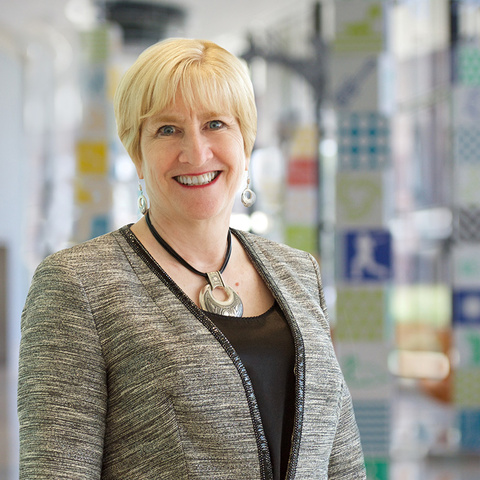
Home for her is New Mexico, and as president and CEO of the New Mexico Cancer Center, she is the driving force behind the state’s first physician-owned multidisciplinary cancer center. She also is the founder and current board chair of the National Cancer Care Alliance, a collaborative group of independent practices providing high-quality, high-value cancer care as well as developing data-driven alternative payment models.
In question-answer format, here are the highlights of a conversation with McAneny during a recent campus visit.
What have been your priorities as AMA president?
One of our goals is to keep health care attainable, but we have to have enough doctors and it has to be affordable. Ninety percent of our spending is on chronic disease, and our infrastructure is built around hospitals. But you don’t really manage people with diabetes or hypertension in hospitals. We’ve been working across the country trying to set up programs to diagnose pre-diabetes and then intervene by having physicians prescribe lifestyle modifications like exercise and dietary information.
We also need to keep the doctors of today working and train more for tomorrow. It used to be a doctor would work until 75 and then retire. Now we have physicians who want out in their 50s. We can’t afford to train somebody for 10 years so they start practicing in their 30s and then burn out when they hit 50 and want to leave the profession. We are looking at the burnout issue considerably because that is a culmination of a lot of the dysfunctions of the health care system.
You have noted that you are the first oncologist, fourth woman, and first New Mexican to be AMA president. Why are those credentials important?
As an oncologist, I see the financial and ethical dilemmas in health care that face the country as well as the patients directly affected. Many examples of the dysfunction in our health care system are examples of patients with cancer—delays of care by prior authorizations, or drugs that are too expensive. For example, if you can cure a lymphoma with CAR T-cells and it costs a lot of money per patient, who is going to pay for it?
Being from New Mexico, I value the diversity of cultures and have learned to be creative in communication. Talking to some of my patients about cancer made me very creative about how I could explain things and connect across cultures, because in the Navajo language there isn’t a word for “cell.” And the difference a woman can bring to the culture of medicine can be very valuable.
As women now make up more than 50% of medical school classes, we can demonstrate the values of human interaction with patients and their families as well as bringing science to create good care.
How did you choose your path as a clinician?
It was a tree of decisions. The first was, do I want to be somebody who cuts—the surgical specialties—or doesn’t cut? I like to think about things, and I don’t like to have to react quickly, so I was going to be a non-cutting physician. I also discovered whenever I had to write a paper, I would find myself back seeing another patient. It finally dawned on me, in about my third year of residency, that if I am doing avoidance behavior on writing the papers, direct patient care is where I could make a difference.
You received a $19.8 million grant from the Centers for Medicare & Medicaid Innovation to develop triage pathways for oncology practices. How did this Community Oncology Medical Home develop?
I wanted to identify the trigger that was putting my patients on a trajectory to the hospital, and then redesign the flow of the practice so we would intervene before that. We reach out and we pull in. By intervening early, the level of hospitalization went down and the patients’ quality of life improved. The doctors’ quality of life improved too, because they were not admitting patients at 2 a.m.
What experiences during your training had the most impact on you?
The University of Iowa is where I turned from a college student into a physician. As a first-year medical student, I volunteered at a free medical clinic for migrant workers. For a girl who is middle class and the daughter of a college professor, that was an eye-opening experience. And when I finished my internal medicine residency, I felt like I could go out and really be an internist. I biopsied kidneys and livers, did procedures, and took care of patients. Iowa was an incredibly hands-on residency, an incredibly valuable way to work. The University of Iowa has a strong oncology program, and I fell in love with all the patients I cared for. Their strength under adversity inspires me.